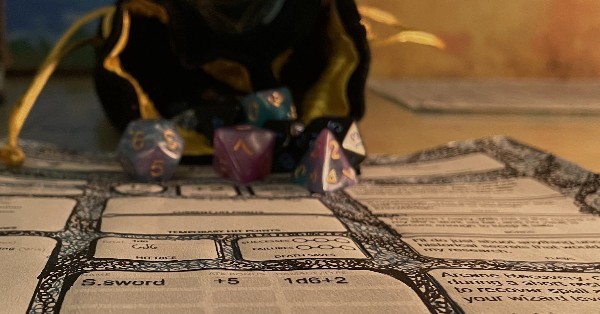You manifest a minor wonder, a sign of supernatural power, within range. You create one of the following magical effects within range:
-
Your voice booms up to three times as loud as normal for 1 minute.
-
You cause flames to flicker, brighten, dim, or change color for 1 minute.
-
You cause harmless tremors in the ground for 1 minute.
-
You create an instantaneous sound that originates from a point of your choice within range, such as a rumble of thunder, the cry of a raven, or ominous whispers.
-
You instantaneously cause an unlocked door or window to fly open or slam shut.
-
You alter the appearance of your eyes for 1 minute.
Casting Time: 1 action
Range: 30 feet
Components: V
Duration: Up to 1 minute
School: Transmutation cantrip
Player’s Handbook, pg. 282
Thaumaturgy 5e
Thaumaturgy is the Cleric-exclusive cantrip that players love to use in a variety of ways. From minor earthquakes to door-slam knockouts, there’s a ton of fun to be had with Thaumaturgy — all while proving that your divine credentials are totally legit.
This article will cover a few rules questions and the common ways that Dungeons and Dragons players use Thaumaturgy in-game.
Who Can Cast Thaumaturgy in 5e?
The following classes have Thaumaturgy on their spell list:
-
Cleric
No subclasses get Thaumaturgy for free. However, Divine Soul Sorcerers have access to the Cleric spell list, and so can access Thaumaturgy. Additionally, Paladins with the Blessed Warrior fighting style have access to Cleric cantrips.
Furthermore, all Tieflings have access to Thaumaturgy from 1st level.
What Does Thaumaturgy Do in 5e?
Thaumaturgy causes one of six effects:
-
3X voice volume for 1 minute
-
Flames brighten, dim, or change color for 1 minute
-
Harmless tremors for 1 minute
-
Minor, instantaneous sound effect
-
Unlocked door/window opens/closes
-
Change eyes
If you need help understanding what Thaumaturgy is, just think of the scene where Gandalf scares Bilbo.
What Are the Rules for Thaumaturgy in 5e?
The rules for Thaumaturgy in DnD 5e are as follows:
-
You cannot communicate with the “ominous whispers” option. They’re just spooky sound effects, according to the game’s devs.
-
You cannot open stuck doors with Thaumaturgy. Only unlocked, unstuck doors can be opened with Thaumaturgy. Sage Advice confirmation.
How Do I Use Thaumaturgy in 5e?
Here are a few ways to use Thaumaturgy in DnD 5e:
3X Voice Volume
-
Boost Intimidation checks
-
Quickly get a crowd’s attention
-
Call out to allies at a far greater distance
-
Shout commands to troops in battle
-
Help sell your scary impersonations (while out of sight)
Change Flames
-
Aid Stealth checks by making a torch’s bright light into dim light
-
Brighten a small fire to aid in Perception/Investigation checks
-
Convince rubes that a changing fire color is a god’s response
-
Cause all flames in a space to flicker and grow as you speak, boosting Intimidation checks
-
Signal from a distance by dimming, brightening, or altering the color of a torch
Tremors
-
Terrify most creatures not accustomed to seeing magic
-
Convince people to quickly leave a structure for fear of collapse
-
Trick creatures into investigating a fake “cave-in”
-
Pair with the “loud voice” effect to make it seem as though your voice is shaking the ground
-
Time tremors when someone steps to make them feel self-conscious
Sound Effect
-
Scare a guard from their post
-
Convince rubes that an area is haunted
-
Trick people into leaving a locked room to investigate
-
Fool a captive into thinking you’re torturing his comrade in the other room
-
Use animal calls for hunting or covert communication
-
Clap thunder to add gravity to an ally’s words
-
Obligatory fart noise suggestion
Door Opening/closing
-
Check for traps from a distance
-
Spook occupants of a room by closing a door from out of their line of sight
-
Quickly slam a door shut to block pursuers while allies barricade it
-
Hit people standing doorways for bludgeoning damage (DM-discretion required)
-
Trick hiding enemies into attacking the moment a door opens
Change Eyes
-
Trick rubes into thinking you’re blind with clouded eyes
-
Make your eyes look snake- or cat-like to scare/ingratiate yourself with a group
-
Sell yourself as an agent of divinity
-
Boost Intimidation checks
-
Combine with “Earth Tremors” and “Amplify Voice” effects to really sell yourself as a true agent of your divinity
-
Convince onlookers that you’re possessed
-
Make yourself look sick or tired
-
Give your eyes an extra-beautiful appearance
Note that for many of these social uses, you’ll have to be careful about where you are in relation to the people you’re trying to fool. After all, the verbal component of the spell is still apparent to all onlookers, which can do a lot to ruin the effect of it seeming like a direct act of your god.
Or, use the Subtle Spell metamagic for extra-convincing fun with Thaumaturgy.
Who Can I Target With Thaumaturgy 5e?
You target either yourself, the entire space, or a specific object with Thaumaturgy.
The voice alteration and eye appearance change are self-targeting effects only.
The flames and tremors effects can target the whole area (all flames and all 30-foot square of space) or a specific flame or patch of ground.
The sound and door effects target a point or specific window/door.
Is Thaumaturgy 5e a Good Spell?
Yes, Thaumaturgy is a good spell as a complement to combat-ready cantrips. It offers heaps of utility, mostly in boosting your social encounters and creating memorable roleplaying moments.
And it’s not like social encounters are unimportant. Pulling off a trick with Thaumaturgy can help your party start an encounter more advantageously (approaching after dimming lights, tricking a guard away from his post, etc.)
It might even help you avoid a combat encounter entirely, depending on the gullibility of your marks, the specifics of the situation, and your DM’s discretion.
Thaumaturgy 5e Compared to a Prestidigitation and Druidcraft
Thaumaturgy often gets compared to the other “minor magical effect” Transmutation cantrips, Prestidigitation (Bards, Sorcerers Warlocks, Wizards, and Artificers) and Druidcraft (Druids and Rangers w/ Druidic Warrior fighting style).
Most agree that Prestidigitation offers the greatest breadth of utility. And, with a potential for 1-hour effects, it’s the longest-lasting cantrip (Thaumaturgy is up to 1 minute, and Druidcraft offers purely instantaneous effects).
Still, there’s very little separating Thaumaturgy and Prestidigitation if you ask most players. Both are fun in different ways and, importantly, in ways that feel on-theme as “starter spells” for the classes that have access to them.
Thaumaturgy 5e DM Tips
One interesting thing that comes up with Thaumaturgy is players trying to get combat utility with it. There are some obvious ones (with less obvious rulings), like using Thaumaturgy to make a Create Bonfire spell bigger. Players might argue for an extra damage die or something like that.
Or, they might make a natural flame bigger and try to get some fire damage out of it that way, or try to blind creatures by brightening flames that creatures are looking at. Or they might try to distract someone with a loud voice and earth tremors to give an ally advantage on their attack. The list goes on.
My feeling on these sorts of scenarios is that it’s great to reward players for creative problem-solving, BUT it’s also not fun to allow for power creep to turn the cantrip into a reliable weapon of 1st-level spell power.
So give your players that fun moment where it really works (if they succeed on appropriate ability checks/enemies fail appropriate saving throws), but also let them know that it’s not a mechanic they can rely on to work every time.


![Flaming Sphere 5e [DnD Spell Guide: Uses, Rules, Tips] find-familiar-5e](https://www.dndlounge.com/wp-content/uploads/2022/03/find-familiar-5e-300x159.jpg)
![Shape Water 5e [DnD Spell Guide: Uses, Rules, Tips] dnd-5e-character-sheet-and-die](https://www.dndlounge.com/wp-content/uploads/2022/03/dnd-5e-character-sheet-and-die-300x157.jpg)
![Spike Growth 5e [DnD Spell Guide: Uses, Rules, Tips] entangle-5e-druid](https://www.dndlounge.com/wp-content/uploads/2022/03/entangle-5e-druid-300x174.jpg)
![Shillelagh 5e [DnD Spell Guide: Uses, Rules, Tips] owlbear-dnd-5e](https://www.dndlounge.com/wp-content/uploads/2022/03/owlbear-dnd-5e-300x218.jpg)